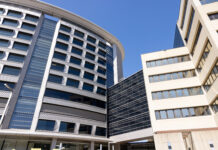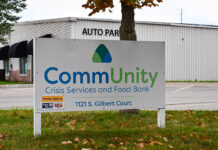
The name chosen for Iowa’s newest regional branding initiative in Central Iowa may have a familiar ring to residents of the seven-county Creative Corridor in East Central Iowa, but that’s about where the similarities end.
The Cultivation Corridor brand for a 60-mile radius of Des Moines that includes Ames was created to develop a regional image as a leader in agricultural and bioscience innovation, according to Brent Willett, executive director of the new effort. It’s a title to which no other region has yet laid claim, said Mr. Willett, and one in which the Central Iowa region has a potent concentration of resources.
In addition to such private companies as DuPont Pioneer, Kemin, Syngenta and Monsanto, the region is home to Iowa State University, the U.S. Department of Agriculture’s National Laboratory for Agriculture and the Environment and National Animal Disease Center.
The selection of the World Food Prize Hall in Des Moines on April 21 to unveil the brand was symbolic.
“We will play a central role in solving some of the world’s most pressing problems in the next century,” Mr. Willett said, referring to population growth and the need for improved food production methods.
The brand was created by Flynn Wright, a Des Moines marketing and public relations firm. The initiative also carries a tag line: “The science that feeds the world.”
Dee Baird, CEO of the Cedar Rapids Metro Economic Alliance, doesn’t believe the similarity of names will cause brand confusion with the Creative Corridor. She says the Central Iowa branding initiative took an entirely different approach than the one taken by the Corridor Business Alliance to find this region’s “authentic brand.”
“It was to find the brand for the seven-county region of Benton, Cedar, Iowa, Johnson, Jones, Linn and Washington counties – not for a specific sector,” Ms. Baird explained in an e-mail. She said the brand narrative is focused on how our region’s people are all creative.
Mr. Willett, who came onboard last month, has already been with one Iowa corridor, the North Iowa Corridor Economic Development Corp., which spans Mason City, Clear Lake and Cerro Gordo County. He’s also done a stint as executive director of the Fairfield Economic Development Corp.
“We certainly acknowledge that there are a lot of corridors out there,” Mr. Willett said. “We think the terminology in the Cultivation Corridor and the ‘Science that feeds the world’ really captures who we are now and what we can be moving forward.”
Mr. Willett believes the branding strategies of the Creative Corridor and the Cultivation Corridor do not overlap and will complement one another as their branding campaigns more strongly imprint their branding messages within their markets. He said the Cultivation Corridor will not limit its focus to the geographical territory of its 60-mile radius of Des Moines if it uncovers opportunities that will be a better fit for other areas of the state.
The launch of the Cultivation Corridor brought together some of the state’s heaviest political hitters, including Gov. Terry Branstad and former governor and USDA Secretary Tom Vilsack. It is a product of Capital Crossroads, a multi-year strategic planning effort for the Greater Des Moines area, co-chaired by Iowa State University President Steven Leath and Des Moines attorney Steve Zumbach.
The amount of advance planning and strategizing made it clear that the branding campaign had a good chance of success and made it hard for Mr. Willett to even consider turning down the opportunity to lead the effort, he said. The previous professional experience of Mr. Leath working in one of the most prominent regional clusters of innovation, the Research Triangle of North Carolina, and his commitment to make ISU a partnership university in economic development, was clearly demonstrated in the effort, added Mr. Willett.
Although the $1.5 million initial budget for the campaign may sound impressive, it is actually not large for a nationwide campaign of the type the Cultivation Corridor envisions.
“Hypertargeted” is the term Mr. Willett uses for Cultivation Corridor’s marketing approach. It will limit its spending carefully to business leaders, site consultants and media channels that can help bring economic activity to the region’s ag/bioscience sector.
Beyond attracting employers, Mr. Willett said the Cultivation Corridor will aim to enhance the image of the area as a place to work in the ag and biosciences industry.
“This is not your grandpa’s agriculture,” is a slogan Mr. Willett likes to use.
Selling Iowa comes with some distinct challenges. Iowans are much better at being modest than at talking about how successful they are, Mr. Willett says, even in an area like ag/bioscience in which the state’s successes are enviable.
“Secondly, we have not managed to share the economics and quality of life that the ag-bioscience economy has to offer,” said Mr. Willett.
Although Ames and Des Moines have collaborated on many fronts, Mr. Willett believes the Cultivation Corridor will raise that collaboration to a new level. He is currently working in the offices of the Ames Chamber of Commerce, one of the partner organizations in the Cultivation Corridor, but will eventually be housed in new facilities in the Iowa State University Research Park. He also has an office at the Greater Des Moines Partnership.
In the end, Mr. Willett says the goal of the initiative is to put Central Iowa in a select club of regions with a national reputation for excellence and innovation in a specific field – think life sciences in San Francisco, aerospace in Wichita, or animal science in Kansas City.
Des Moines may always remain known as an insurance capital and Ames as a university town. In fact, Mr. Willett said, were it not for the effectiveness of existing economic development initiatives within the region, it would be impossible to pursue specialization.
“This is where we think we can play – agriculture and bioscience,” he said.





